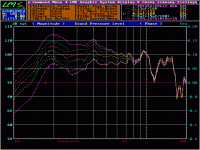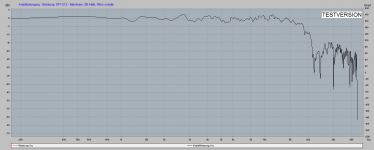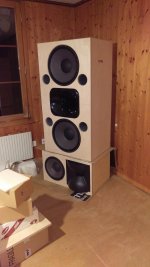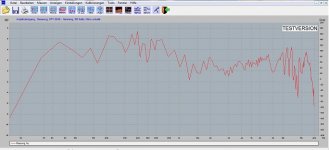This horn is the one from the 4425 monitor. With a passive crossover quite an effort is needed to tame those peaks. The HF drop OTOH isn't that much of a deal even with a passive crossover because one would need a voltage divider to match level with the woofer. Such a divider can eaily be turned into a shelving filter.
Regards
Charles
Regards
Charles
eek, I don't like those peaks (resonances).
Raw data (no smoothing) with LMS are not very pretty. If you think this is bad, wait till you see some dome tweeters.
Here's another plot, this time a Pyle PDS382 1" Compression driver with a Pyle PH612. If the hump at 2K is left uncorrected, it will result in the dreaded horn "honk".
Mike
Attachments
When you consult the data sheets of the eighteensound HF drivers there is no mentioning of any copper demodulation ring either.
OTOH from the Faital Datasheet one can at least see that they have an underhung motor with quite some Xmax - meaning that one will stay within a small percentage of its linear excursion - even at loud domestic listening levels.
Regards
Charles
" The ND1480A powerful neodymium magnet assembly has been designed to obtain 22 KGauss in the gap for major benefits in transient response. The motor structure, throughout the precisely coherent phase plug with 3 circumferential slots and copper ring on the pole piece, reduces inductance effects and distortion."
a friends 2342 + 2204 +18
Custom Made JBL 4430 2245H 2344 2204 Studio Monitors Biamp 18" inch Subwoofer | eBay
crossover by jbl engineer +/-1db (far better than stock 4722).
It was a studio monitor (the horn) so I'm sure it is very good.
Norman
Custom Made JBL 4430 2245H 2344 2204 Studio Monitors Biamp 18" inch Subwoofer | eBay
crossover by jbl engineer +/-1db (far better than stock 4722).
It was a studio monitor (the horn) so I'm sure it is very good.
Norman
I'd use the 1464.
My 2 only beefs is that the 2206 sound like an old man getting out of bed until you have maybe 10 watts into it (very rugged suspension built to take 300watts rms), and specs necessitate a subwoofer (qts .32 and Fs 52hz).
I haven't found this to be the case- 10W into a 2206 would be VERY loud.
When one looks at the data sheet of the original 4430 monitor one can clearly see that the most ragged response is in the range where the horn is in action.
https://www.google.ch/url?url=https...jRdfMA&usg=AFQjCNEmh64fflgfLNkvpNq06XgvBZoJwQ
But one has to be aware that it is all within +- 2 dB approx. The room response will give a larger error than that in most cases.
Thats what I wanted to do tonight actually. Unfortunatley the mic preamp doesn't want to work tonight unfortunately. I will have to repair that one first before I can do any proper measurements and adjustments. In the meantime I used Sigma Studio to set up a 3rd/2nd order Lipshitz Vanderkooy crossover at 1 kHz. With some shelving that was set up by ear at the lower and upper end it sounds quite smooth and effortless. Most astonishing is the bass impact even at low listening volumes. Let's see how it turns out with a proper measurement the next few days.
Regards
Charles
https://www.google.ch/url?url=https...jRdfMA&usg=AFQjCNEmh64fflgfLNkvpNq06XgvBZoJwQ
But one has to be aware that it is all within +- 2 dB approx. The room response will give a larger error than that in most cases.
I'd bet applying DSP would tame the ragged response & make it highly "listenable" & sweet sounding...Jealous!!
Thats what I wanted to do tonight actually. Unfortunatley the mic preamp doesn't want to work tonight unfortunately. I will have to repair that one first before I can do any proper measurements and adjustments. In the meantime I used Sigma Studio to set up a 3rd/2nd order Lipshitz Vanderkooy crossover at 1 kHz. With some shelving that was set up by ear at the lower and upper end it sounds quite smooth and effortless. Most astonishing is the bass impact even at low listening volumes. Let's see how it turns out with a proper measurement the next few days.
Regards
Charles
In the meantime I had some other things to do but I nonetheless did some measuring and tweaking. The active crossover topology that I use is asymmetrical with a 2nd order lowpass and 3rd order highpass of Special construction. Although I also use an additional Bessel lowpass on the woofer as delay.
The crossover's properties lie somewhere between a LR2 and a 3rd order Butterworth. I.e. its lobing behaviour is a bit better than BW3 but slightly worse than LR2. It is constant voltage with the acoustic crossover point at -5dB approx. The power Response is slightly worse than the BW3's but better than that of the LR2. Another interesting property is the group delay (or actually Group delay distortion which is lower than that of LR2 and BW3 (below 250us for the 1kHz crossover frequency used here).
I will add a Phase EQ tomorrow and have a look at what we can do about the step response by further reducing the already low group delay distortion).
Here you can see the measured in-room amplitude response.
With the tool used (ADI's Sigma Studio) it would of course be possible to achieve a better linearity but I don't know whether it would make sense.
Regards
Charles
The crossover's properties lie somewhere between a LR2 and a 3rd order Butterworth. I.e. its lobing behaviour is a bit better than BW3 but slightly worse than LR2. It is constant voltage with the acoustic crossover point at -5dB approx. The power Response is slightly worse than the BW3's but better than that of the LR2. Another interesting property is the group delay (or actually Group delay distortion which is lower than that of LR2 and BW3 (below 250us for the 1kHz crossover frequency used here).
I will add a Phase EQ tomorrow and have a look at what we can do about the step response by further reducing the already low group delay distortion).
Here you can see the measured in-room amplitude response.
With the tool used (ADI's Sigma Studio) it would of course be possible to achieve a better linearity but I don't know whether it would make sense.
Regards
Charles
Attachments
Last edited:
Have a look at, Pi Speakers - unmatched quality and state-of-the-art performance, it might give you more insight !
In the meantime I was working on my large MTMs. It took me much longer than expected. It was planned to have them finished about one month ago and being currently building a large three way that was designed many months ago.
But nonetheless here they are, standing in my workshop. Lacking decent stands I just took an older design of mine for that purpse (no fear - it is quite sturdy !). Tonight I will start finetuning the crossover with AD SigmaStudio. They have only been formally tested so far with the headphone output of a small radio and the woofer sections have been tested with a six string bass and a 500 Watt bass amp.
Regards
Charles
But nonetheless here they are, standing in my workshop. Lacking decent stands I just took an older design of mine for that purpse (no fear - it is quite sturdy !). Tonight I will start finetuning the crossover with AD SigmaStudio. They have only been formally tested so far with the headphone output of a small radio and the woofer sections have been tested with a six string bass and a 500 Watt bass amp.
Regards
Charles
Attachments
After a bit of playing around with Sigma Studio the response looks like this. I have increased the level of the LF channel a bit according to subjective taste but will do the dropping response thing a little differently later on in order to avoid that downsloping ramp between 500 Hz and 1 kHz. They are generally within +- 3dB from 40 Hz to 18 kHz (apart from the hole at 13 kHz).
I will further fine tune as soon as I can shlepp them outside for measurements with less room influenece.
Regards
Charles
I will further fine tune as soon as I can shlepp them outside for measurements with less room influenece.
Regards
Charles
Attachments
When I first played around a little some weeks ago I did shoot some short videos with my mobile phone. Keep in mind that not only the chain is quite low end (Discman -> DSP crossover with EVAL kit -> cheap PA amps), but the room is also my acoustically untreated workshop. To make things worse, the phone records in some fake Stereo Fashion and ist ALC applies quite some dynamic compression.
But here they are:
https://youtu.be/ccCwl6t3oGM
https://youtu.be/FKf9h_LtDuw
https://youtu.be/Ls-ri-8ZveY
https://youtu.be/qDFzMElHw9c
Have fun
Charles
But here they are:
https://youtu.be/ccCwl6t3oGM
https://youtu.be/FKf9h_LtDuw
https://youtu.be/Ls-ri-8ZveY
https://youtu.be/qDFzMElHw9c
Have fun
Charles
- Status
- This old topic is closed. If you want to reopen this topic, contact a moderator using the "Report Post" button.
- Home
- Loudspeakers
- Multi-Way
- Two way with PA drivers



